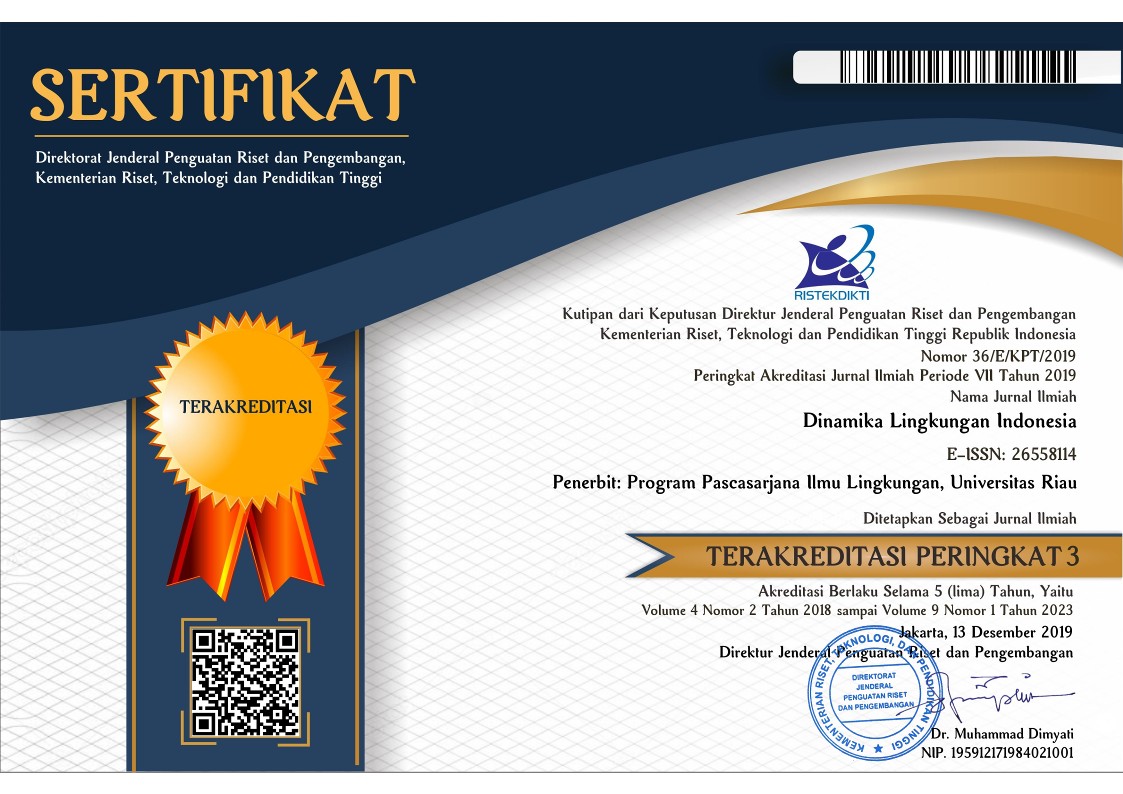Makrofauna Tanah Sebagai Bioindikator pada Areal Perkebunan yang diberi Limbah Cair Pabrik Kelapa Sawit Sebagai Pupuk
Abstract
Research on Soil Macrofauna as Bioindicator in Plantation Areas Given Palm Oil Mill Liquid Waste as Fertilizer was conducted in 2021. Samples were taken in Long Bed, Flat Bed, and Control areas using Purposive Sampling and Squares and Hand Sorting methods. Each location is determined by 9 sampling points. Soil macrofauna samples were identified in the USU FMIPA Ecology laboratory. From the results of the study, there were 3 soil macrofauna phyla, namely the Annelida phylum, which consisted of 1 class, 1 order, 2 families, and 2 species. Phylum Arthropoda consists of 5 classes, 10 orders, 16 families, and 27 species. Phylum Mollusca consists of 1 class, 1 order, 1 family, and 1 species. The highest population density (K) was obtained from the species Macrotermes gilvus, which was 81.10 individuals/m2 in the Control area, followed by Ponthoscolex corethrurus at 78.81 individuals/m2 in the Flat Bed area. The highest relative density (KR) was found in the species Macrotermes gilvus, which was 49.1% in the control area, followed by Ponthoscolex corethrurus at 46.84% in the Long Bed area. The highest frequency of presence (FK) was found in the Ponthoscolex corethrurus species, which was 100% in the Control and Flat Bed areas, and 88.88% in the Long Bed areas. Species that can live and reproduce well as bioindicators are Ponthoscolex corethrurus in the Long Bed area, followed by the Flat Bed and Control areas. The highest diversity index value was found in the Flat Bed area, which was 3,831 with the criteria for diversity being high, the distribution of the number of individuals for each species was high, the community stability was good and the soil community had not been polluted, while the Equitabilitas value was 1,258 with the criteria for high uniformity, stable community. The application of palm oil mill effluent as fertilizer to the plantation area can increase the life of the soil macrofauna, and the physical-chemical properties of the soil.
Keywords
Full Text:
PDFReferences
Afridi, M. C. (2021). “Komposisi Komunitas Makrofauna Insecta Tanah Pada Areal Pekebunan Kelapa Sawit Yang Di beri Limbah Cair Kelapa Sawit”. [Skripsi]. Fakultas Matematika & Ilmu Pengetahuan Alam. Universitas Sumatera Utara. Medan. Hlm: 22.
Arlen, H. J. (2020). “Makrofauna Tanah Sebagai Bioindikator Pada Lahan Perkebunan Kelapa Sawit”. [Disertasi]. Fakultas Matematika & Ilmu Pengetahuan Alam. Universitas Sumatera Utara. Medan. Hlm: 1-131.
Haneda NF, Sirait BA, (2012). Diversity of Soil Fauna and It’s Role in Litter Decomposition of Oil Palm (Elaeis guineensis Jacq). Bogor. Jurnal Silvikultur Tropika. 3 (3): 161-167. https://doi.org/10.29244/j-siltrop.3.3.%25p.
Kementerian Pertanian Direktorat Jendral Perkebunan Ditjenbun. Tahun 2021.
Marichal, R., M. Grimaldi., J. Mathieu., G. Brown., T. Desjardins., M. Lopes., C. Praxedes., M. B. Martins., E. Velasquez., P. Lavelle. (2012). Is Invasion of Deforested Amazonia by Earthworm Pontoscolex corethrurus Driven by Soil Texture & Chemical Properties? Pedobiologia. 55: 233-240. http://dx.doi.org/10.1016/j.pedobi.2012.03.006.
Nurrohman, E., Rahardjanto, A., & Wahyuni, S. (2015). Keanekaragaman Makrofauna Tanah Di Kawasan Perkebunan Coklat (Theobroma cacao L). Sebagai Bioindikator Kesuburan Tanah & Sumber Belajar Biologi. Jurnal Pendidikan Biologi Indonesia, 1(2): 197-208. https://doi.org/10.22219/jpbi.v1i2.3331.
Nursanti, I (2013). Karakteristik Limbah Cair Pabrik Kelapa Sawit Pada Proses Pengolahan Anaerob & Aerob. Jurnal Ilmiah Universitas Batanghari Jambi, 8 (4). http://dx.doi.org/10.33087/jiubj.v13i4.324.
Rosmalinda, & Susanto, A. (2018). Aplikasi Limbah Cair Pabrik Kelapa Sawit Dalam Memperbaiki Sifat Kimia Tanah Gambut. Jurnal Teknologi Agro-Industri. 5 (2): 59. https://doi.org/10.34128/jtai.v5i2.71.
Sabrina, A. T. & Sembiring, Mariani. (2017). Perkembangan Cacing Pontoscolex corethrurus Pada Media Kultur Dengan Berbagai Jenis Tekstur Tanah dan Bahan Organik Growth of Pontoscolex corethrurus on Culture Media With Various Soil Texture & Organic Matter. Jurnal Agroteknologi. 5 (2): 329-337.
Sari, Martala dan Lestari, Maya. (2014). Kepadatan & Distribusi Cacing Tanah Di Areal Arboretum Dipterocarpaceae 1,5 Ha Fakultas Kehutanan Universitas Lancang Kuning Pekanbaru. Jurnal Lectura. 5 (1): 92.
Tambunan, D. S., Nelvia, & Amri, A. I. (2019). Aplikasi Limbah Cair Pabrik Kelapa Sawit Dengan Metoda Biopori Terhadap Pertumbuhan Tanaman Kelapa Sawit (Elaeis guineensiss Jacq.) Belum Menghasilkan. Jurnal Solum. 16(1): 19-28. https://doi.org/10.25077/jsolum.16.1.19-28.2019.
DOI: http://dx.doi.org/10.31258/dli.9.2.p.72-79
Refbacks
- There are currently no refbacks.





